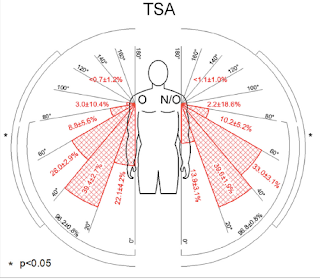These authors measured the total daily shoulder motion of patients after TSA and RTSA in 36 subjects using a custom instrumented garment that tracked upper extremity motion for the waking hours of 1 day.
94% of shoulder motion occurred below 80° of elevation for total shoulders, reverse total shoulders and shoulders contralateral to the surgical shoulder. In the diagrams below "O" refers to the surgical shoulder while "N/O" refers to the contralateral shoulder.
Comment: While many surgeons focus on the postoperative range of motion after a shoulder arthroplasty as a measure of the effectiveness of the procedure, this study suggests that the range of motion above 100 degrees is rarely used by the patient.
The lack of a strong relationship between shoulder motion and function was demonstrated recently by this paper:
Relationship Between Patient-Reported Assessment of Shoulder Function and Objective Range-of Motion Measurements
For both female and male patients, they found a poor correlation between objective measurements of active abduction and the total SST scores of osteoarthritic shoulders (square symbols). The relationships between active abduction and total SST score were only fair for the contralateral shoulders (diamond symbols).
The key finding in this study was that the active range of motion correlated poorly with the patients' self-assessed function of their osteoarthritic shoulders, meaning that the shoulder function was dependent on characteristics of the shoulder and the patient other than the active range of motion. 100 degrees of active elevation appears to enable patients to perform most of their daily activities.
In 74 male and 30 female patients with osteoarthritis these authors analyzed the relationship between the Simple Shoulder Test patient self-assessments of shoulder function and objective range-of-motion measurements recorded by the observer-independent Kinect motion capture system
For both female and male patients, they found a poor correlation between objective measurements of active abduction and the total SST scores of osteoarthritic shoulders (square symbols). The relationships between active abduction and total SST score were only fair for the contralateral shoulders (diamond symbols).
Interestingly, these authors found that shoulders unable to perform the different activities of the SST averaged less than 100 degrees of abduction
The key finding in this study was that the active range of motion correlated poorly with the patients' self-assessed function of their osteoarthritic shoulders, meaning that the shoulder function was dependent on characteristics of the shoulder and the patient other than the active range of motion. 100 degrees of active elevation appears to enable patients to perform most of their daily activities.
====
The reader may also be interested in these posts:
Consultation for those who live a distance away from Seattle.
Click here to see the new Shoulder Arthritis Book.
Click here to see the new Rotator Cuff Book
Information about shoulder exercises can be found at this link.
Use the "Search" box to the right to find other topics of interest to you.
You may be interested in some of our most visited web pages including:shoulder arthritis, total shoulder, ream and run, reverse total shoulder, CTA arthroplasty, and rotator cuff surgery as well as the 'ream and run essentials'
See from which cities our patients come.
See the countries from which our readers come on this post.
The reader may also be interested in these posts:
Consultation for those who live a distance away from Seattle.
Click here to see the new Shoulder Arthritis Book.
Click here to see the new Rotator Cuff Book
Information about shoulder exercises can be found at this link.
Use the "Search" box to the right to find other topics of interest to you.
You may be interested in some of our most visited web pages including:shoulder arthritis, total shoulder, ream and run, reverse total shoulder, CTA arthroplasty, and rotator cuff surgery as well as the 'ream and run essentials'
See from which cities our patients come.
See the countries from which our readers come on this post.







